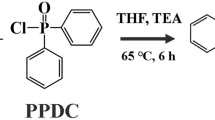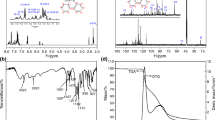Abstract
To enhance the flame retardancy and mechanical performance of epoxy resin, a P/N-containing oligomer, polyphosphate amide (PPA) was synthesized by 1,4-phenylenediamine with dimethyl methyl phosphonate without using any organic solvent. With only 2% PPA addition in EP, the sample passed the UL-94 V-0 grade, and its limited oxygen index reached 34.0%. In the cone calorimeter test, the peak heat release rate, total heat release, and total smoke release of the EP containing 2% PPA were reduced by 23.6%, 16.0%, and 22.7% compared with that of control EP, respectively. The toughness of the pure EP was 5.0 MJ m−3, and its impact strength and shear strength were 4.1 kJ m−2 and 8.4 MPa, respectively. With 2% PPA, the toughness, impact strength, and shear strength of EP/PPA2 were increased to 10.3 MJ m−3, 8.8 kJ m−2, and 14.8 MPa, respectively. This work provided a green and feasible strategy to fabricate a flame-retardant oligomer that was capable of enhancing the mechanical performance and fire resistance of the EP simultaneously.








Similar content being viewed by others
References
Chowaniec-Michalak A, Czarnecki S, Sadowski Ł, Królicka A. Recycling of waste limestone powders for the cleaner production of epoxy coatings: fundamental understanding of the mechanical and microstructural properties. J Clean Prod. 2022;372:133828. https://doi.org/10.1016/j.jclepro.2022.133828.
Zhao D, Liu W, Shen Y, Wang TW. A novel ceramifiable epoxy composite with enhanced fire resistance and flame retardance. J Therm Anal Calorim. 2022;147:181–93. https://doi.org/10.1007/s10973-020-10200-4.
Wang AQ, Zhang F, Xing LP, Zhu YL, Xie WL, Chen X, et al. Effect of aluminum diethylphosphinate and its synergist on flame-retardant effects of epoxy resin. J Therm Anal Calorim. 2022;147(13):7277–87. https://doi.org/10.1007/s10973-021-11045-1.
Liang DX, Zhu XJ, Dai P, Lu XY, Gu XQ, Que H, et al. Preparation of a novel lignin-based flame retardant for epoxy resin. Mater Chem Phys. 2021;259(17):124101. https://doi.org/10.1016/j.matchemphys.2020.124101.
Jiao E, Wu K, Qu ZC, Liu YC, Lu MP, Nan BF, et al. Preparation and curing kinetics of intrinsic flame retardant epoxy resin system based on polyoxometalates. J Therm Anal Calorim. 2021;146:1063–76. https://doi.org/10.1007/s10973-020-10075-5.
Dong X, Ma Y, Fan XG, Zhao S, Xu YX, Liu S, et al. Nickel modified two-dimensional bimetallic nanosheets, m (oh)(och3) (m=co, ni), for improving fire retardancy and smoke suppression of epoxy resin. Polymer. 2021;235:124263. https://doi.org/10.1016/j.polymer.2021.124263.
Kavitha D, Murugavel SC, Thenmozhi S. Flame retarding cardanol based novolac-epoxy/rice husk composites. Mater Chem Phys. 2021;6:124225. https://doi.org/10.1016/j.matchemphys.2021.124225.
Liu FY, Zhao H, Hu WD, Xu JZ, Jiao YH, Qu HQ, et al. The synergistic flame retardant, smoke suppressant, and thermal degradation properties of spherical CoSn(OH)6 and ammonium polyphosphate on epoxy resin. J Therm Anal Calorim. 2022;147:9431–50. https://doi.org/10.1007/s10973-021-11188-1.
Liu DY, Ji PF, Zhang TL, Lv JP, Cui YH. A bi-DOPO type of flame retardancy epoxy prepolymer: synthesis, properties and flame-retardant mechanism. Polym Degrad Stabil. 2021;190:109629. https://doi.org/10.1016/j.polymdegradstab.2021.109629.
Zhou KQ, Gong KL, Gao FY, Yin L. Facile strategy to synthesize MXene@ LDH nanohybrids for boosting the flame retardancy and smoke suppression properties of epoxy. Compos Part A-Appl S. 2022;157:106912. https://doi.org/10.1016/j.compositesa.2022.106912.
Zhou X, Qiu SL, Mu XW, Zhou MT, Cai W, Song L, et al. Polyphosphazenes-based flame retardants: a review. Compos Part B-Eng. 2020;202(5):108397. https://doi.org/10.1016/j.compositesb.2020.108397.
Afzal A, Tariq A, Shakir F, Satti AN, Taimoor M, Ghani U, et al. Development and characterization of multifunctional carbon fabric-reinforced polymer composites incorporated with inorganic flame retardants. Polym Compos. 2020;41(8):3043–51. https://doi.org/10.1002/pc.25596.
Xue YJ, Ma ZW, Xu XD, Shen MX, Huang GB, Bourbigot S, et al. Mechanically robust and flame-retardant polylactide composites based on molecularly-engineered polyphosphoramides. Compos Part A-Appl S. 2021;144(5):106317. https://doi.org/10.1016/j.compositesa.2021.106317.
Duan HJ, Chen YS, Ji S, Hu R, Ma HR. A novel phosphorus/nitrogen-containing polycarboxylic acid endowing epoxy resin with excellent flame retardance and mechanical properties. Chem Eng J. 2019;375:121916. https://doi.org/10.1016/j.cej.2019.121916.
Tang H, Zhu ZM, Chen R, Wang JJ, Zhou H. Synthesis of DOPO-based pyrazine derivative and its effect on flame retardancy and thermal stability of epoxy resin. Polym Adv Technol. 2019;30(9):2331–9. https://doi.org/10.1002/pat.4674.
Reuter J, Greiner L, Kukla P, Döring M. Efficient flame retardant interplay of unsaturated polyester resin formulations based on ammonium polyphosphate. Polym Degrad Stabil. 2022;178:109134. https://doi.org/10.1016/j.polymdegradstab.2020.109134.
Cheng C, Wang Y, Lu YL, Li SJ, Li H, Yan J, et al. Bio-based arginine surface-modified ammonium polyphosphate: an efficient intumescent flame retardant for epoxy resin. RSC Adv. 2022;12(15):9223–37. https://doi.org/10.1039/d1ra09459a.
Dong HX, Wang YX, Feng TT, Piao JX, Ren JY, Wang YF, et al. Phytic acid doped polyaniline-coupled g-C3N4 nanosheets for synergizing with APP promoting fire safety and waterproof performance of epoxy composites. Polym Degrad Stabil. 2022;198:109879. https://doi.org/10.1016/j.polymdegradstab.2022.109879.
Wang W, Liu Y, Wen H, Wang Q. Synthesis of a hyperbranched polyamide charring agent and its flame-retarding and toughening behavior in epoxy resin. Polym Degrad Stabil. 2020;184(26):109479. https://doi.org/10.1016/j.polymdegradstab.2020.109479.
Chen CL, Xiao GQ, Zhong F, Dong ST, Yang ZW, Chen CY, et al. Synergistic effect of carbon nanotubes bonded graphene oxide to enhance the flame retardant performance of waterborne intumescent epoxy coatings. Prog Org Coat. 2022;162:106598. https://doi.org/10.1016/j.porgcoat.2021.106598.
Chao PJ, Li YJ, Gu XY, Han DD, Jia XQ, Wang MQ, et al. Novel phosphorus–nitrogen–silicon flame retardants and their application in cycloaliphatic epoxy systems. Polym Chem-UK. 2015;6(15):2977–85. https://doi.org/10.1039/c4py01724b.
Hu X, Yang HY, Jiang YP, He HL, Liu HY, Huang H, et al. Facile synthesis of a novel transparent hyperbranched phosphorous/nitrogen-containing flame retardant and its application in reducing the fire hazard of epoxy resin. J Hazard Mater. 2019;379:120793. https://doi.org/10.1016/j.jhazmat.2019.120793.
Jian RK, Ai YF, Xia L, Zhao LJ, Zhao HB. Single component phosphamide-based intumescent flame retardant with potential reactivity towards low flammability and smoke epoxy resins. J Hazard Mater. 2019;371:529–39. https://doi.org/10.1016/j.jhazmat.2019.03.045.
Qiu Y, Qian LJ, Feng HS, Jin SL, Hao JW. Toughening effect and flame-retardant behaviors of phosphaphenanthrene/phenylsiloxane bigroup macromolecules in epoxy thermoset. Mrc. 2018;51(23):9992–10002. https://doi.org/10.1021/acs.macromol.8b02090.
Chu FK, Ma C, Zhang T, Xu ZM, Mu XW, Cai W, et al. Renewable vanillin-based flame retardant toughening agent with ultra-low phosphorus loading for the fabrication of high-performance epoxy thermoset. Compos Part B-Eng. 2020;190:107925. https://doi.org/10.1016/j.compositesb.2020.107925.
Li Z, Liu CC, Cao WH, Yao Q. Reactive cyclic phosphonamide flame retardant for epoxy resins. J Appl Polym Sci. 2020;137(1):47411. https://doi.org/10.1002/app.47411.
Jeng RJ, Wang JR, Lin JJ, Liu YL, Chiu YS, Su WC. Flame retardant epoxy polymers using phosphorus-containing polyalkylene amines as curing agents. J Appl Polym Sci. 2001;82(14):3526–38. https://doi.org/10.1002/app.2215.
Li B, Zhan ZS, Zhang HF, Sun CY. Flame retardancy and thermal performance of polypropylene treated with the intumescent flame retardant, piperazine spirocyclic phosphoramidate. J Vinyl Addit Technol. 2014;20(1):10–5. https://doi.org/10.1002/vnl.21337.
Feng JB, Ma ZW, Xu ZG, Xie HY, Lu YX, Maluk C, et al. A Si-containing polyphosphoramide via green chemistry for fire-retardant polylactide with well-preserved mechanical and transparent properties. Chem Eng J. 2022;431:134259. https://doi.org/10.1016/j.cej.2021.134259.
Zhang JH, Mi XQ, Chen SY, Xu ZJ, Zhang DH, Miao MH, et al. A bio-based hyperbranched flame retardant for epoxy resins. Chem Eng J. 2020;381:122719. https://doi.org/10.1016/j.cej.2019.122719.
Teng N, Dai JY, Wang SP, Hu JY, Liu XQ. Hyperbranched flame retardant for epoxy resin modification: simultaneously improved flame retardancy, toughness and strength as well as glass transition temperature. Chem Eng J. 2022;428:131226. https://doi.org/10.1016/j.cej.2021.131226.
Liu XF, Liu BW, Luo X, Guo DM, Zhong HY, Chen L, et al. A novel phosphorus-containing semi-aromatic polyester toward flame retardancy and enhanced mechanical properties of epoxy resin. Chem Eng J. 2020;380:122471. https://doi.org/10.1016/j.cej.2019.122471.
Peng XL, Li ZK, Wang DH, Li ZF, Liu CB, Wang R, et al. A facile crosslinking strategy endows the traditional additive flame retardant with enormous flame retardancy improvement. Chem Eng J. 2021;424:130404. https://doi.org/10.1016/j.cej.2021.130404.
Yuan Y, Shi YQ, Yu B, Zhan J, Zhang Y, Song L, et al. Facile synthesis of aluminum branched oligo(phenylphosphonate) submicro-particles with enhanced flame retardance and smoke toxicity suppression for epoxy resin composites. J Hazard Mater. 2020;381:121233. https://doi.org/10.1016/j.jhazmat.2019.121233.
Fang YZ, Miao JS, Yang XW, Zhu Y, Wang GY. Fabrication of polyphosphazene covalent triazine polymer with excellent flame retardancy and smoke suppression for epoxy resin. Chem Eng J. 2020;385:123830. https://doi.org/10.1016/j.cej.2019.123830.
Lu CJ, Bian S, Hu K, Li CC, Zheng KW, Sun QF. Biomass-based epoxy resin derived from resveratrol with high temperature resistance and intrinsic flame retardant properties. Ind Crop Prod. 2022;187:115500. https://doi.org/10.1016/j.indcrop.2022.115500.
Cao YF, Wang ZR, Wang JL, Wei YA, Yu S. Chitosan-bridged synthesis of 2D/2D hierarchical nanostructure towards promoting the fire safety and mechanical property of epoxy resin. Compos Part A-Appl S. 2022;158:106958. https://doi.org/10.1016/j.compositesa.2022.106958.
Wang JL, Wei Y, Wang ZR, He XR, Wang C, Lin H. MOFs-derived self-sacrificing template strategy to double-shelled metal oxides nanocages as hierarchical interfacial catalyst for suppressing smoke and toxic gases releases of epoxy resin. Chem Eng J. 2022;432:432. https://doi.org/10.1016/j.cej.2021.134328.
Xu YJ, Chen L, Rao WH, Qi M, Guo DM, Liao W, et al. Latent curing epoxy system with excellent thermal stability, flame retardance and dielectric property. Chem Eng J. 2018. https://doi.org/10.1016/j.cej.2018.04.097.
Ren XY, Zou B, Zhou YF, Zhao ZX, Qiu AL, Song L. Construction of few-layered black phosphorus/graphite-like carbon nitride binary hybrid nanostructure for reducing the fire hazards of epoxy resin. J Colloid Interface Sci. 2020. https://doi.org/10.1016/j.jcis.2020.10.139.
Wang JL, Zhou HB, Wang ZR, Bai W, Cao YF, Wei YA. Constructing hierarchical structure based on LDH anchored boron-doped g-C3N4 assembled with MnO2 nanosheets towards reducing toxicants generation and fire hazard of epoxy resin. Compos Part B-Eng. 2021;229(6):109453. https://doi.org/10.1016/j.compositesb.2021.109453.
Qu ZC, Wu K, Meng WH, Nan BF, Hu ZR, Xu CA, et al. Surface coordination of black phosphorene for excellent stability, flame retardancy and thermal conductivity in epoxy resin. Chem Eng J. 2020. https://doi.org/10.1016/j.cej.2020.125416.
Diao WJ, Liu ZJ, Yuan GM, Jiao EX, Wang KX, Yang H, et al. Synergistic effect of zinc borate and microencapsulated black phosphorus nanosheets for improved flame retardancy and smoke-suppression performance of epoxy resin. Polym Degrad Stabil. 2023;214:110404. https://doi.org/10.1016/j.polymdegradstab.2023.110404.
Qiu SL, Zhou YF, Zhou X, Zhang T, Wang CY, Hu Y, et al. Air-stable polyphosphazene-functionalized few-layer black phosphorene for flame retardancy of epoxy resins. Small. 2019. https://doi.org/10.1002/smll.201805175.
Ye XM, Li JJ, Zhang WC, Pan YT, Yang RJ, Li JR. Enhanced fire safety and mechanical properties of epoxy resin composites based on submicrometer-sized rod-structured methyl macrocyclic silsesquioxane sodium salt. Chem Eng J. 2021;425:130566. https://doi.org/10.1016/j.cej.2021.130566.
Acknowledgements
The authors would like to thank the National Natural Science Foundation of China (No.22175017 and No.22075010) for their financial support of this research.
Author information
Authors and Affiliations
Corresponding authors
Ethics declarations
Conflict of interest
The authors declare that they have no competing financial interests or personal relationships that could have appeared to influence the work reported in this paper.
Additional information
Publisher's Note
Springer Nature remains neutral with regard to jurisdictional claims in published maps and institutional affiliations.
Rights and permissions
Springer Nature or its licensor (e.g. a society or other partner) holds exclusive rights to this article under a publishing agreement with the author(s) or other rightsholder(s); author self-archiving of the accepted manuscript version of this article is solely governed by the terms of such publishing agreement and applicable law.
About this article
Cite this article
Li, X., Chen, J., Wu, L. et al. A polyphosphate amide synthesized by a solvent-free route to enhance the flame retardancy and toughness of epoxy resins. J Therm Anal Calorim 148, 11707–11716 (2023). https://doi.org/10.1007/s10973-023-12517-2
Received:
Accepted:
Published:
Issue Date:
DOI: https://doi.org/10.1007/s10973-023-12517-2




